Weapons Systems Tuning Group Reunion
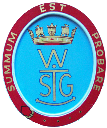
© WSTG Reunion Committee 2016
Go to top of page
George John Scutt (1921-2016)
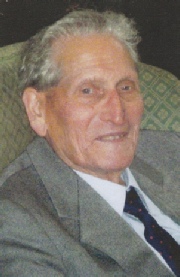 After distinguished wartime service in the Royal Navy, principally as a submariner, George Scutt was demobilized in July 1946. His eventful career in the Navy and with the MoD(N) is related in some detail in George’s Page on this web site. For this obituary a summary of George’s valuable service in the Professional and Technology Officer grades is, however, appropriate.
After distinguished wartime service in the Royal Navy, principally as a submariner, George Scutt was demobilized in July 1946. His eventful career in the Navy and with the MoD(N) is related in some detail in George’s Page on this web site. For this obituary a summary of George’s valuable service in the Professional and Technology Officer grades is, however, appropriate.
George embarked on his long career with MoD(N) in 1947 in the mobile radio group at Funtington Airfield as a radio mechanic. In 1954 a number of groups working on radio and other electronic equipment were transferred to No2 Electrical Workshop, a new purpose built building in Portsmouth Dockyard. Here George worked on various types of equipment, but mainly HF and UHF equipment in the workshop and afloat. He was at this stage a special radio mechanic, soon to be uprated to the Civil Service grade: Technical Grade 3 (Diagnostician).
George volunteered for service in Hong Kong but finished the posting in Gibraltar as RN overseas bases were reducing to peacetime needs.
I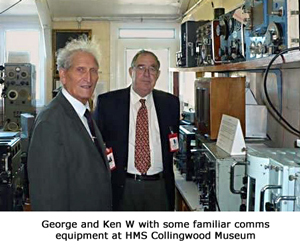 n 1961 George joined WSTG on promotion to TG2/PTO3. He continued to specialize in communications equipment being very much involved in many of the installations of the early Integrated Communications System ICS1. George retired in July 1981 as team leader (PTO2) in the Communications Section.
n 1961 George joined WSTG on promotion to TG2/PTO3. He continued to specialize in communications equipment being very much involved in many of the installations of the early Integrated Communications System ICS1. George retired in July 1981 as team leader (PTO2) in the Communications Section.
In retirement George and his wife Eileen continued to travel abroad and still made regular trips to Kenya until about 6 years ago. George remained very active until quite late in life tending a neat and productive garden and helping his family with various DIY projects.
George’s funeral took place on 6th May 2016 at the Oaks Crematorium in Havant and was attended by family and many friends from his church, St Thomas’, Bedhampton. A small group of WSTG colleagues attended his funeral, which included Ted Arnold, Ken Bevis, Adrian Wright and Ken Wingate.
George leaves his wife of 69 years Eileen, his three daughters and son who led the tributes during the funeral service.

Orien Gladwyn Young (14th May 1931 – 30th September 2016)
T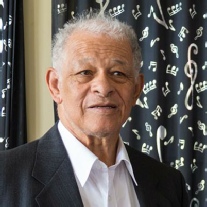 he closure of the Dockyard in Bermuda in 1951 gave a number of Bermudian apprentices the opportunity to come to the UK, complete their training and perhaps embark on a career here in the MoD(N). Orien Young was one of those young men who did just that.
he closure of the Dockyard in Bermuda in 1951 gave a number of Bermudian apprentices the opportunity to come to the UK, complete their training and perhaps embark on a career here in the MoD(N). Orien Young was one of those young men who did just that.
After his death much was said about Orien’s accomplishments as an outstanding sprinter, an athletics coach and official, and his work associated with the transplant games. Indeed the words ‘legendry sports leader’ used by the local newspaper aptly describe Orien. But little was said about his career with the MoD in any of the tributes.
Orien was an electrical-
An initial step for many young electrical fitters on the non-
Orien’s athletic commitments and the driving school run by his wife Shirley, where he did some part time instructing, made his Bath posting most undesirable. However, he retained his confirmed post by transferring to Bath on ‘detached duty due to return’ basis.
At this time Tony Morriss (later to become another WSTG colleague) was also at Bath. Tony M. recalls that Orien stayed in a hotel opposite where he had a flat. Here, Orien would often demonstrate his culinary skills by cooking dinner for both of them.
Orien never neglected his athletics training during his Bath posting and used the Admiralty sports ground at Claverton, which is now part of the University campus. On one occasion he had his clothes stolen while he was out on the track! Tony Morriss came to the rescue and arranged for a friend to lend him a suit for the rest of that week!
In 1965 Orien volunteered for a post in WSTG, transferring back to Portsmouth as a TG2/PTO3 where he joined the Radar and EW section. He specialized in Electronic Support Measures in submarines, working on many boats throughout the UK, built for the Royal Navy and for the Navies of other countries. The RN boats were being equipped with outfits UA8 and UA9 at this time.
The Polaris submarines (the SSBN programme) gave Orien the opportunity for a period of detached duty in the United States and the chance to visit his father and other family members more easily.
On return from the US Orien continued in the Radar and EW Section where, once again, he met up with John Farmer, who had been appointed the Radar and EW section leader. Orien remained a team leader in that section until the late 1970s when he transferred to the surface weapons section dealing with Seawolf missile ship fitted equipment.
The introduction of the Type 22 frigates provided WSTG with the challenge of forming a management and setting to work team for the Seawolf missile systems beyond HMS Broadsword, the first of class platform. The integration of a setting to work team comprising a small number of WSTG Personnel and a large number of the contactor’s staff was not an initial success. Moreover, the sudden death of Eric Tarpley who was part of the management team made the WSTG element more short staffed. However Orien’s transfer to this section as part of the mobile management team helped considerably to improve the WSTG/contractor relationships. At this time WSTG also contributed a wealth of experience in proving interfaces/links to other equipment in the Type 22 frigates, often resulting in changes and modifications. From this aspect of the work Orien acquired a further responsibility as the liaison officer between WSTG and the Ship Weapons System Engineers, with a desk in their Portsdown offices.
I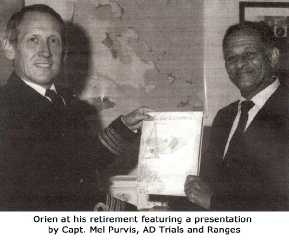 n the 1980s a significant reorganization, saw a reduction in WSTG staffing with departures to other areas of work and staff transfers to the Trials and Ranges group within the same Directorate. In 1983 Orien joined the Trials and Ranges group to become the Autec Support Manager and spent his remaining years before retirement on work associated with the Atlantic Test and Evaluation Centre in the United States. For the next 9years he spent 6months of each year at Cape Canaveral Florida! He retired as a Senior Professional Technology Officer in September 1992.
n the 1980s a significant reorganization, saw a reduction in WSTG staffing with departures to other areas of work and staff transfers to the Trials and Ranges group within the same Directorate. In 1983 Orien joined the Trials and Ranges group to become the Autec Support Manager and spent his remaining years before retirement on work associated with the Atlantic Test and Evaluation Centre in the United States. For the next 9years he spent 6months of each year at Cape Canaveral Florida! He retired as a Senior Professional Technology Officer in September 1992.
A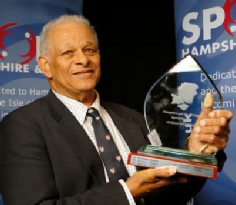 t Orien’s funeral, held at the Oaks Crematorium Havant, on 27th October 2016 tributes a small group of WSTG colleagues gathered to remember Orien. Tributes were paid to him for his work, over many years in national and international athletics. Less well known to many attendees was his work promoting the Transplant Games, a forerunner of the Para-
t Orien’s funeral, held at the Oaks Crematorium Havant, on 27th October 2016 tributes a small group of WSTG colleagues gathered to remember Orien. Tributes were paid to him for his work, over many years in national and international athletics. Less well known to many attendees was his work promoting the Transplant Games, a forerunner of the Para-
Postscript. In an email, on an entirely different matter, from Tony Morriss came these concluding words:
‘Sorry for the delay in replying but I am on passage to the Caribbean to escape the English winter and will not return until end February so not able to attend. However, stopped at Bermuda on way and spoke with people who remembered Orien Young and then a brief visit to Cocoa Beach where he spent so much time so some good memories of an old friend’ .

Bert Norris
I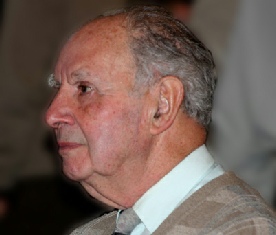 t is with sadness that we have to report the death of Bert Norris who passed away on Sunday 9th October 2016 at the age of 96.
t is with sadness that we have to report the death of Bert Norris who passed away on Sunday 9th October 2016 at the age of 96.
Bert’s was a veteran of the Arctic Convoys and also saw service in the Mediterranean and the Far East. His eventful life and career is well documented on “Bert’s page” in the members section of the website.
Peter Horrocks
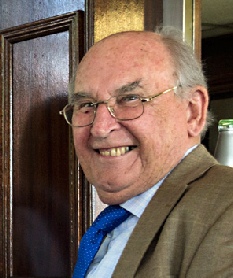 Peter Horrocks died at Queen Alexandra Hospital, Portsmouth on Christmas Day 2016. He was 81 years old.
Peter Horrocks died at Queen Alexandra Hospital, Portsmouth on Christmas Day 2016. He was 81 years old.
Peter joined WSTG in the early 1960s transferring from Devonport Dockyard to Portsmouth. He worked on the first four County Class Destroyers (DLGs) on the Ops Room displays and links to the sensors and weapons. On the second batch of DLGs he continued with work on computer systems (DAB) before preparing to work on CAAIS employing the FM1600B computer.
In the mid-
He was further promoted to Grade 7 in the early 1980s and served at ASWE Portsdown, followed by a short spell back in WSTG and then with DGSS (Portsdown) from where he retired in 1995.
Peter will be remembered for his resourcefulness and determination. Despite poor health it is recalled that he re-
In retirement he also devoted much of his spare time to Lawn Bowls.
Our sympathy is extended to his wife June and his family.